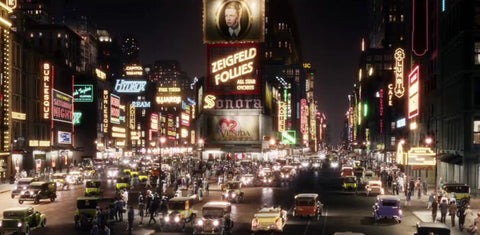Francis Cugat’s 1925 ‘Celestial Eyes’ design for F. Scott Fitzgerald’s the Great Gatsby is one of the most iconic book covers of all time. It’s also unusual in that the artwork influenced the story. Cugat finished the illustration before the final manuscript was submitted, and Fitzgerald wrote to his editor Maxwell Perkins, “For Christ’s sake don’t give anyone that jacket you’re saving for me. I’ve written it into the book.”

By saying that he’d “written into the book” could Fitzgerald have meant narrator Nick Carraway’s description of Daisy as a “‘girl whose disembodied face floated along the dark cornices and blinding signs’ of New York at night.” Or perhaps the eyes of Dr TJ Eckleburg on a giant billboard in the valley of ashes?
My guess is the former, I think the eyes of Dr TJ Eckleburg are too integral to the story to have been added for the final draft.

The eyes of Dr. T.J. Eckleburg from The Great Gatsby, Jack Clayton, 1974
Daisy’s face is described by narrator Nick Carraway in the book as “sad and lovely with bright things in it, bright eyes and a bright passionate mouth.” Dr. T.J. Eckleberg’s eyes are “blue and gigantic…they look out of no face, but, instead, from a pair of enormous yellow spectacles which pass over a non-existent nose.” Cugat’s illustration seems to combine these two images, though primarily I think it is Daisy.
Perhaps the triangular composition of the disembodied face with no nose represents the love triangle of Daisy, Tom and Gatsby. Or Myrtle (Tom’s mistress), Tom and Daisy.

If you look closely you can see the pupils of the eyes are stylised reclining female nudes – perhaps representing Daisy in Gatsby’s eyes?

The green light on Daisy’s dock, from The Great Gatsby, Jack Clayton, 1974
The green tear streaming from her eyes in the illustration is like the light “that burns all night” at the end of Daisy’s dock, representing the American dream tantalisingly just out of Gatsby’s reach. It’s reflected in the water on the illustration, just as it’s reflected in the sound between Daisy’s and Gatsby’s houses in the book.
The Great Gatsby is full of light motifs with parties illuminated by “enough coloured lights to make a Christmas tree of Gatsby’s enormous garden.” Nick sees “the whole corner of the peninsula . . . blazing with light” from Gatsby’s house “lit from tower to cellar.” When Nick tells Gatsby that his place “looks like the World’s Fair,” Gatsby proposes that they “go to Coney Island.”
This is represented in the fairground image on the illustration, which also perhaps symbolises the bright lights of New York City.

New York City from The Great Gatsby, Baz Luhrmann, 2013

Francis Cugat’s original 1925 gouache painting
Our Great Gatsby Out of Print t-shirt featuring the book cover
I’m a huge fan of the book and the 1974 film, so I’m interested to see Luhrmann’s film when it comes out in the UK on May 16th. It will be the fifth film adaptation of the novel. I’ll leave you with the trailer.


